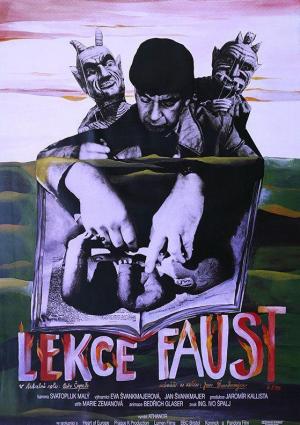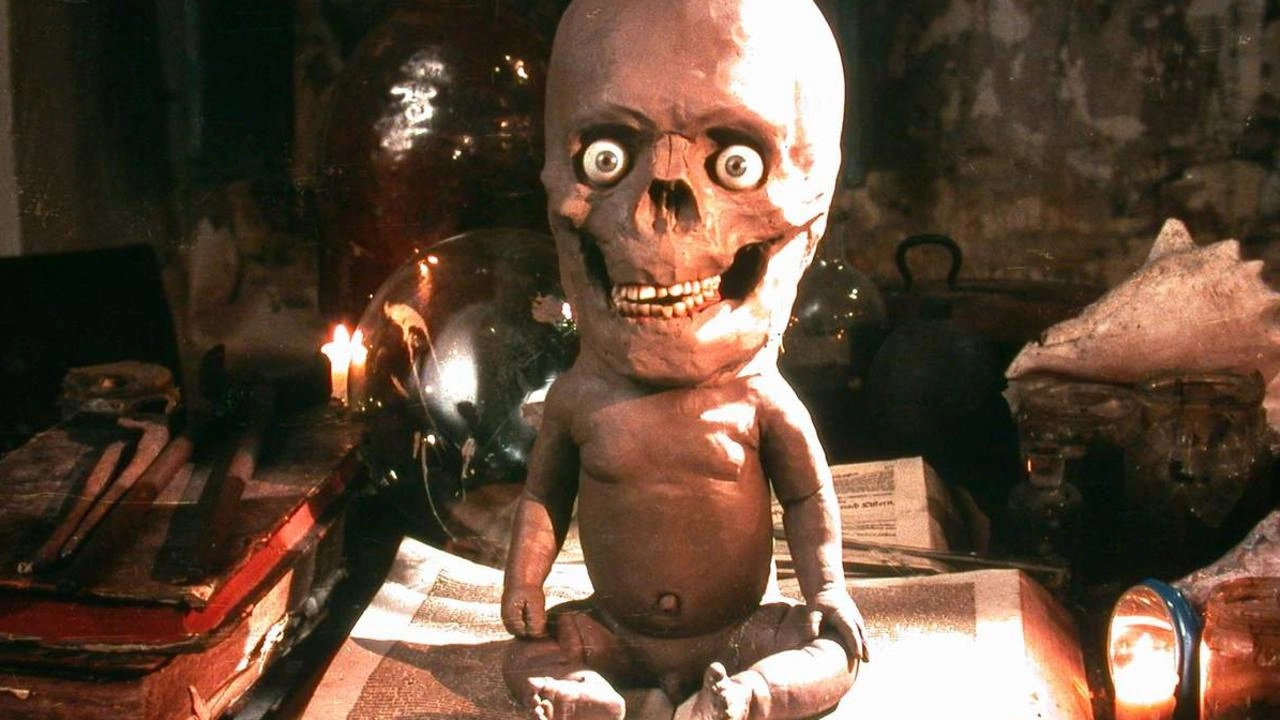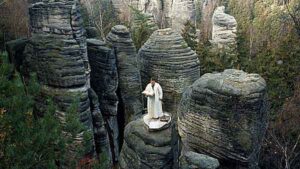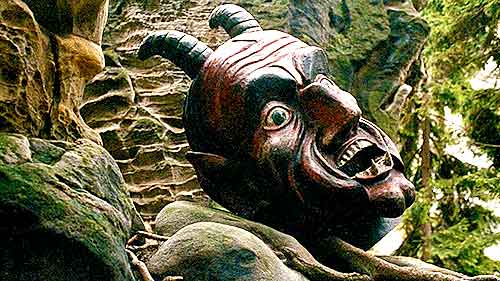A 1994 adaptation of the legend of Faust and his dealings with the Devil that’s so unorthodox I can’t help but wonder if it was truly intended as FAUST. By this I mean to say I strongly suspect that writer-director Jan Svankmajer began with a non-FAUST related story to which he later grafted elements from Goethe’s FAUST and Christopher Marlowe’s THE TRAGICAL HISTORY OF DOCTOR FAUSTUS. That being said, in this Czech-BBC co-production Svankmajer created a film that’s challenging, surreal and uniquely his own.
The protagonist (Petr Cepek), who’s referred to as both Faust and Faustus, begins his odyssey as a nondescript everyman attempting to subside in a dehumanizing modern metropolis where transients nonchalantly carry around severed body parts and eggs are found in loaves of bread. Upon being given a map one day, Faust/Faustus decides to follow where it leads, which turns out to be a downtown theater in which puppets cavort, manipulated by human hands whose bodies and faces are never seen. Faust/Faustus is inspired to put on ornate robes and smear make-up on his face, and finds himself reciting lines from Marlowe and Goethe.
Among the surreal sights on display in this theater are the Devil’s messenger Mephistopheles, portrayed as a roiling ball of clay that transforms into a replica of the main character’s face, and a marionette clown that delights in summoning and banishing a marionette devil, causing the latter to constantly run in out of the theater. Faust/Faustus, meanwhile, enacts the events of the Marlowe and Goethe dramas, in which the devil is summoned and offers the protagonist untold riches in exchange for his immortal soul.
As is his wont, Svankmajer mixes in a lot of miscellaneous bizarrie. Among the latter are self-sweeping brooms, a troupe of ballerinas who spend more time raking grass than they do dancing, an outdoor eatery in which wine is served from a hole drilled in the middle of a table, bowling pins are situated on the surface of water, tiny marionette angels are beaten and ravished by equivalent sized marionette devils, and a very human miscreant (Jan Kraus) is on hand to monitor, and influence, the protagonist’s every move.
That last part is indicative of how radically the Faust story was changed in this film, with Faust/Faustus acting on external forces rather than his own lust for power (the gist of the Marlowe and Goethe dramas). Svankmajer had many—perhaps too many—ideas, turning out a film that functions as both a spoof and surreal deconstruction of the Faust narrative. This may explain why the proceedings often feel like a succession of short subjects rather than a long-form narrative (an issue that in fairness afflicts most of Svankmajer’s features).
With art direction by Svankmajer’s late wife Eva Svankmajerova (a character every bit as brilliant and complicated as he), FAUST can safely be crowned the most visually sumptuous of Svankmajer’s features. A full roster of effects are utilized, including traditional stop motion, Claymation and puppeteering, reminding us of Svankmajer’s beginnings as an animator. The Svankmajerova designed setting is a tricky one, alternating between surreal theater interiors and outdoor settings in which the artificiality of the indoor portions, and the marionette characters, are nonetheless carried over.
Svankmajer’s filmmaking is unorthodox, to say the least. The sound mixing places great emphasis on footsteps, rustling paper and other incidental noises, combined with extreme close-ups included without editorial justification of any sort. Svankmajer has claimed his main intent as a filmmaker was to convey a sense of touch—and also, I’d argue, taste, which would explain all the scenes of people (and in one scene a marionette) eating, an act viewed as unseemly in traditional filmmaking circles but in which Svankmajer positively revels.
The net result is an annoying, obtuse, perverse and pretty astonishing piece of unadorned surrealism that ranks with the best of Bunuel, Dali and just about anyone else you can think of. FAUST is, however, pure Jan Svankmajer through and through, and ultimately won’t be confused with the work of anyone else.
Vital Statistics
FAUST (Lekce Faust)
Athanaor/British Broadcasting Corporation/ Centre national du cinéma et de l’image animée (CNC)
Director/Screenplay: Jan Svankmajer
Producer: Jaromir Kallista
Cinematography: Svatopluk Maly
Editing: Marie Zemanova
Cast: Petr Cepek, Jan Kraus, Vladimir Kudla, Antonin Zecpal, Jiri Suchy, Viktorie Knotkova, Jana Mazlova, Miluse Strakova, Josef Fiala, Martin Radimecky, Ervin Tomenendal, Frantisek Polata, Josef Chodora, Karel Vidimsky, Petr Meissel, Rudolf Ruzek, Milan Vyskocil, Pavel Marek, Dalibor Fencl, Robert Blanda




